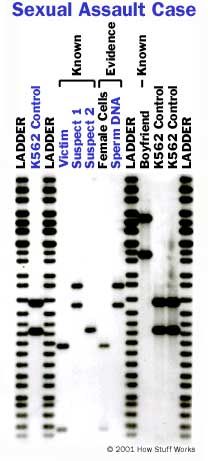Matching DNA
The main objective of DNA analysis is to get a visual representation of DNA left at the scene of a crime. A DNA "picture" features columns of dark-colored parallel bands and is equivalent to a fingerprint lifted from a smooth surface. To identify the owner of a DNA sample, the DNA "fingerprint," or profile, must be matched, either to DNA from a suspect or to a DNA profile stored in a database.
Let's consider the former situation -- when a suspect is present. In this case, investigators take a DNA sample from the suspect, send it to a lab and receive a DNA profile. Then they compare that profile to a profile of DNA taken from the crime scene. There are three possible results:
Advertisement
- Inclusions -- If the suspect's DNA profile matches the profile of DNA taken from the crime scene, then the results are considered an inclusion or nonexclusion. In other words, the suspect is included (cannot be excluded) as a possible source of the DNA found in the sample.
- Exclusions -- If the suspect's DNA profile doesn't match the profile of DNA taken from the crime scene, then the results are considered an exclusion or noninclusion. Exclusions almost always eliminate the suspect as a source of the DNA found in the sample.
- Inconclusive results -- Results may be inconclusive for several reasons. For example, contaminated samples often yield inconclusive results. So do very small or degraded samples, which may not have enough DNA to produce a full profile.
Sometimes, investigators have DNA evidence but no suspects. In that case, law enforcement officials can compare crime scene DNA to profiles stored in a database. Databases can be maintained at the local level (the crime lab of a sheriff's office, for example) or at the state level. A state-level database is known as a State DNA index system (SDIS). It contains forensic profiles from local laboratories in that state, plus forensic profiles analyzed by the state laboratory itself. The state database also contains DNA profiles of convicted offenders. Finally, DNA profiles from the states feed into the National DNA Index System (NDIS).
To find matches quickly and easily in the various databases, the FBI developed a technology platform known as the Combined DNA Index System, or CODIS. The CODIS software permits laboratories throughout the country to share and compare DNA data. It also automatically searches for matches. The system conducts a weekly search of the NDIS database, and, if it finds a match, notifies the laboratory that originally submitted the DNA profile. These random matches of DNA from a crime scene and the national database are known as "cold hits," and they are becoming increasingly important. Some states have logged thousands of cold hits in the last 20 years, making it possible to link otherwise unknown suspects to crimes.
